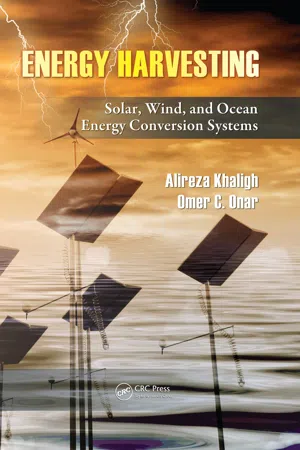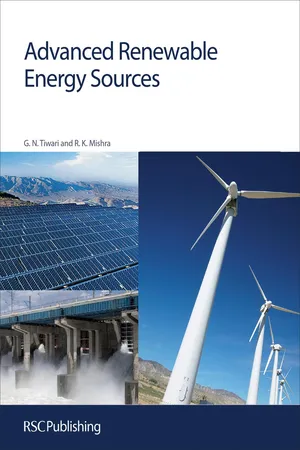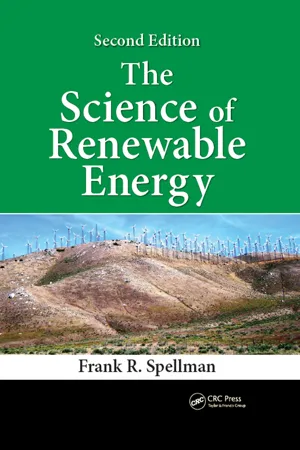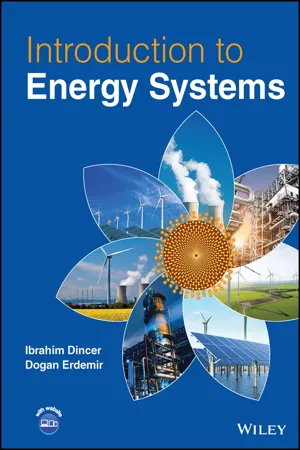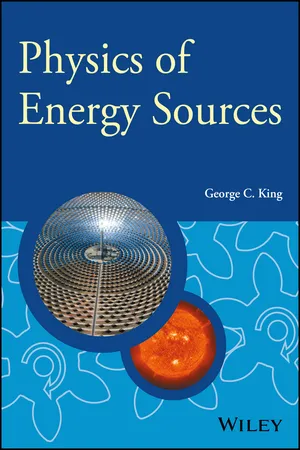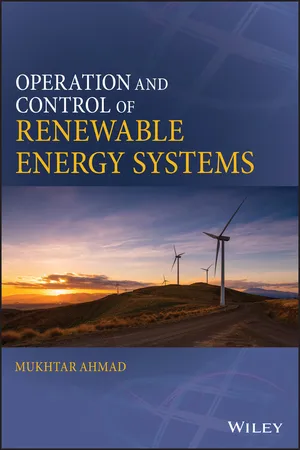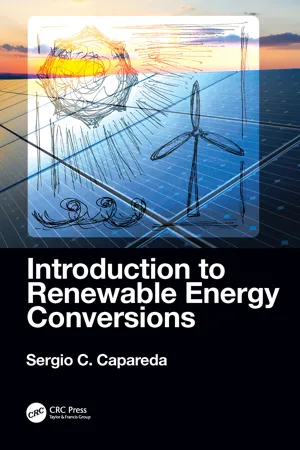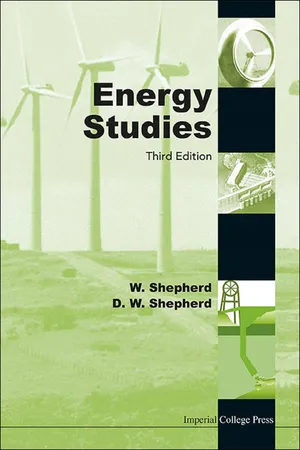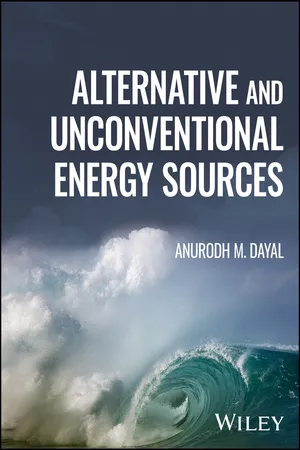Physics
Wind Energy
Wind energy is a renewable energy source that harnesses the power of the wind to generate electricity. It is produced by wind turbines, which convert the kinetic energy of the wind into mechanical power. This power is then used to drive generators that produce electricity. Wind energy is a clean and sustainable alternative to traditional fossil fuels.
Written by Perlego with AI-assistance
Related key terms
10 Key excerpts on "Wind Energy"
- eBook - ePub
Energy Harvesting
Solar, Wind, and Ocean Energy Conversion Systems
- Alireza Khaligh, Omer C. Onar(Authors)
- 2017(Publication Date)
- CRC Press(Publisher)
2 Wind Energy Harvesting2.1 Introduction
Wind is the airflow that consists of many gases in the atmosphere of the earth. Rotation of the earth, uneven heating of the atmosphere, and the irregularities of the ground surface are the main factors that create winds. Motion energy of the wind flow is used by humans for many purposes such as water pumping, grain milling, and generating electricity. Windmills that are used for electricity generation are called wind turbines in order to distinguish them from the traditional mechanical wind power applications.Wind is a sustainable energy source since it is renewable, widely distributed, and plentiful. In addition, it contributes to reducing the greenhouse gas emissions since it can be used as an alternative to fossil-fuel-based power generation [1 ]. Wind turbines capture the kinetic energy of winds and convert it into a usable form of energy. The kinetic energy of winds rotates the blades of a wind turbine. The blades are connected to a shaft. The shaft is coupled to an electric generator. The generator converts the mechanical power into electrical power.Even though wind turbines currently provide only 1% of the worldwide power supply, Wind Energy is one of the fastest growing renewable energy technologies all over the world. In countries such as Denmark, Spain, Portugal, and Germany, wind power accounts for approximately 19%, 9%, 9%, and 6% of the required electric power, respectively. From 2000 to 2007, the global wind power generation increased to approximately five times of its previously recorded capacity [2 ].Wind Energy conversion systems (WECS) involve many fields of various disciplines such as kinematics, mechanics, aerodynamics, meteorology, power electronics, power systems, as well as topics covered by structural and civil engineering. The main focus of this book is on electrical power interfaces and grid-connected topologies for WECS.This chapter firstly focuses on some basic features of winds. A brief history of Wind Energy is presented in Section 2.3 . Fundamentals of Wind Energy harvesting, basic parts of wind turbines, and the wind turbine types are described in Sections 2.4 and 2.5 - eBook - ePub
- Gopal Nath Tiwari, Rajeev Kumar Mishra(Authors)
- 2015(Publication Date)
- Royal Society of Chemistry(Publisher)
CHAPTER 7 Wind Energy7.1 INTRODUCTION
In the past, Wind Energy was used (i) to propel ships (ii) to produce mechanical energy for pulling up underground water from wells and (iii) grinding agriculture products. There is also evidence that suggests that the ancient Egyptians used windmills to pump water for irrigating agricultural lands and to grind grains during 3600 B.C. Wind is simply air in motion that carries kinetic energy with it. The kinetic energy is converted into first mechanical and then electrical energy by generation. The mechanical energy of wind can be used for driving ships, pumping water, grinding grains, etc.The harnessing of electrical power from wind is gaining momentum due to the depletion of fossil fuels and their rising running cost. Moreover, Wind Energy is considered to be a green/clean power technology. It has minor impacts on the economy and environment. Hence, Wind Energy, which is a renewable sources of energy, can be harnessed to provide an environmentally friendly and reliable source of energy without producing any air pollutants or greenhouse gases. The kinetic energy of wind is captured by the wind turbine that is mechanically coupled to an electrical generator. The turbine is mounted on a tall pillar to enhance the energy capture. In the 19th century, wind turbines contributed greatly to the economic development of many countries like the Netherlands, Denmark and the USA. The use of Wind Energy declined very fast everywhere due to the cheap availability and exploitation of coal, oil and gas resources.The old wind turbines were no longer economically competitive with conventional sources of energy. Therefore, very little research was done to develop new and more efficient wind turbines. Due to the energy crisis during 1973 the development of new and more efficient wind turbines was resumed to generate electricity. As a result, the cost of electricity produced by wind turbines decreased dramatically due to improved technology. Nowadays, the extraction of electrical power with modern turbines from the wind is an established industry. A device for direct mechanical work is often called a windmill or just wind turbines. If electricity is produced, the combination of turbine and generator may be called a wind generator or aerogenerator that is also referred as a Wind Energy-conversion system (WECS) - eBook - ePub
- Frank R. Spellman(Author)
- 2016(Publication Date)
- CRC Press(Publisher)
wind power.Wind generator—A Wind Energy conversion system designed to produce electricity.Wind load—The lateral pressure on a structure, in pounds per square foot, due to wind blowing in any direction.Wind power—Power generated by converting the mechanical energy of the wind into electrical energy through the use of a wind generator. See also Wind Energy.Wind power plant—A group of wind turbines interconnected to a common utility system.Wind project—Can vary in size, from small projects of one to a few turbines (known as “behind the meter” or “distributed wind systems”) serving individual customers to large projects (“utility” or “commercial-scale”) designed to provide wholesale electricity to utilities or an electricity market.Wind turbine—A Wind Energy conversion device that produces electricity; it typically consists of three major mechanical components: tower, nacelle, and rotor.Wind turbine lay-down area—An area adjacent to the wind turbine foundation where wind turbine components are temporarily stored, assembled, or processed as part of the wind turbine assembly operation.AIR IN MOTION
In all dynamic situations, forces are necessary to produce motion and changes in motion. The atmosphere, which is made up of various gases, is subject to two primary forces: gravity and pressure differences from temperature variations. Gravity (gravitational forces) holds the atmosphere close to the Earth’s surface. Newton’s law of universal gravitation states that every body in the universe attracts another body with a force equal toF = G()m 1m 2r 2where F is the magnitude of the gravitational force between the two bodies, G is the gravitational constant ≈ 6.67 × 10−11 N (m2 /kg2 ), m1 and m2 are the masses of the two bodies, and r is the distance between the two bodies.The force of gravity decreases as an inverse square of the distance between the two bodies. Thermal conditions affect density, which in turn affects vertical air motion and planetary air circulation (and how air pollution is naturally removed from the atmosphere). Although forces acting in other directions can overrule gravitational force, gravity constantly acts vertically downward, on every gas molecule, which accounts for the greater density of air near the Earth. - eBook - ePub
- Ibrahim Dinçer, Dogan Erdemir(Authors)
- 2023(Publication Date)
- Wiley(Publisher)
7 Wind Energy 7.1 Introduction Renewable energy is generally known as the energy coming from a natural source in a renewable manner which is not depleted when used, such as wind. So, this means that we will never run out of wind source as long as the universe survives. Wind Energy is not a new source of energy for humanity. Since ancient times, it has been used to meet specific needs, including milling, lifting water, elevating objects, etc. In such systems, the kinetic energy of wind (air) is converted into mechanical power, which is then used for useful purposes. As far as Wind Energy systems are concerned, the principle remains the same. Today, when Wind Energy is considered, electricity comes to mind. In light of today’s energy sources and potential choices, some may wonder, why wind power is considered? It is, of course, a renewable resource that should be the first response. It is also environmentally benign and sustainable as it exists naturally. Furthermore, it is abundant; it produces no greenhouse gas emissions or other toxic emissions during power generation; and the source is free. It has relatively higher efficiency than other renewables. It is a commercially viable and cost-effective energy conversion system. It has many types of diverse applications. It can be applied to all sectors. Almost all of them are reliable systems. Today, their manufacturer’s warranties have reached up to 20–30 years. Today, Wind Energy is a proven and mature technology for the energy sector due to its practical advantages. Its contribution to the world energy supply has been ever-increasing, and Figure 7.1, in this regard, shows how the global wind power capacity has changed over time, between 1995 and 2021 which shows an exponential increase. Its recorded data for the wind power was about 4 GW - eBook - ePub
- George C. King(Author)
- 2017(Publication Date)
- Wiley(Publisher)
6 Wind power We have already seen that the Sun delivers a huge amount of energy to the Earth's surface. Approximately 2% of this is converted into Wind Energy. This is a small fraction but still amounts to a global wind power of ∼2 × 10 12 kW. The purpose of wind turbines is to harvest some of this power. A wind turbine as described in this chapter is a machine that converts wind power into electricity, usually to supply electricity to a national grid. This is in contrast to a windmill, which converts wind power into mechanical power. Wind power has important advantages. It is a renewable energy source and it is also a clean source; it does not release harmful gases into the environment. Moreover, wind turbines can deliver power to remote areas that are not connected to a national grid. The main disadvantage is, of course, that the wind is variable and so is an intermittent source of energy. This means that wind turbines must be used in conjunction with other energy sources and/or energy storage systems. Nevertheless, because of its advantages, it is anticipated that wind power will in the future contribute at least 20% of global energy requirements. In this chapter we describe the origin and directions of the wind and how a wind turbine works. As we are dealing with the flow of air, a fluid, through the blades of the turbine, it is also appropriate to introduce the physics of fluid flow. However, we first give a brief history of wind power. 6.1 A brief history of wind power The use of wind power has a long history that goes back thousands of years. The first known historical reference is from the Greek mathematician and engineer Hero of Alexandria (c. 10–70 AD). He described a windmill that provided air to drive a musical organ. (Hero of Alexandria is also credited with the invention of the first steam engine.) In the following centuries the main use of wind power was to perform mechanical work. Holland, a flat and windy country, is famous for its use of windmills - Mukhtar Ahmad(Author)
- 2017(Publication Date)
- Wiley(Publisher)
Fig. 7.1 ).Cumulative installed wind power capacity 1980–2013.Figure 7.1Power generation from onshore Wind Energy is already being integrated into electricity supply system without any problem. Although average wind speeds vary considerably by location, it is possible to extract significant amount of Wind Energy in most regions of the world. In some areas with good wind resources, the cost of Wind Energy is already competitive with the current energy market prices, even without considering relative environmental impacts. Nonetheless, in most regions of the world, continued advances in onshore and offshore Wind Energy technologies are required for further reducing the cost of Wind Energy and improving GHG emission reduction potential.7.2 Power and Energy in Wind
The wind power depends on the mass of airflow rate (density) m, velocity of air v, passing through an area of interest A [3, 4].The kinetic energy by definition is given by7.1here m is given bywhere ρ = density of air. Power in wind is kinetic energy per unit time,7.27.3From the aforementioned expression, it is clear that the power available in wind is proportional to the cube of wind speed. The wind turbines are used to convert this kinetic energy of moving air into mechanical energy. The energy that a wind turbine will produce depends on both its wind speed–power curve and the wind speed frequency distribution at the site. Histogram showing the number of hours for which the wind blows at different wind speeds during a given period of time is used to determine the wind speed frequency distribution. From the histogram, operating range of the wind speed of the turbine (the speed between shutdown speed and cut-in speed) is obtained. The energy produced by the turbine at a particular speed is obtained by multiplying the number of hours of its duration by the turbine power at that speed. This data is used to plot Wind Energy distribution curve as shown in Fig. 7.2- eBook - ePub
- Sergio Capareda(Author)
- 2019(Publication Date)
- CRC Press(Publisher)
3Wind Energy
Learning Objectives
Upon completion of this chapter, one should be able to:- Estimate the available Wind Energy from actual wind speed data.
- Enumerate the various Wind Energy applications.
- Define maximum and practical conversion efficiencies.
- Describe the instruments used to measure Wind Energy.
- Design the size and dimensions of a windmill appropriate for a given site or application.
- Relate the overall environmental and economic issues concerning Wind Energy conversion systems.
3.1 Introduction
Wind Energy is a consequence of solar energy. The earth receives heat from the sun on one side (the side facing the sun) while its opposite side cools. This uneven heating of the earth gives rise to wind movement. In the heated regions, air rises as a result of a decrease in density while being replaced by cooler, slightly dense wind, creating movement. The rising of hot air is a frequent and basic occurrence. This event is depicted in Figure 3.1 . In addition, since the earth moves on its own axis, a tangential component of wind movement exists, giving way to easterly or westerly wind directions, called trade winds. There are also local variations in wind movements due to the presence of mountains and barriers, such as vegetation or forest cover.Extracting energy from the wind is achieved by designing a device that converts the kinetic energy from the wind into mechanical energy by way of windmills and wind aero-generators.In the past, water pumping in most parts of the United States relied on multi-bladed windmills. Such windmills move at quite slow speeds, producing high torque as necessary for pumping water from deep wells. As we have harnessed mechanical power into electrical power using electromagnets, engineers have now also designed very efficient wind aero-generators that convert Wind Energy into electrical energy. However, these generators require quite high speeds and necessitate the use of windmills that move at a faster rate. These are usually wind generators with a few blades each. One might assume that the more blades a windmill has, the faster it goes, but in fact, the fastest wind aero-generators are those with fewer blades. It is indeed possible to design a windmill with only a single blade. In this design, there must be a counterweight on the opposite end of a single-bladed windmill so that there will be no imbalance in weight distribution. The most popular wind aero-generators for generating electrical power are those with two, three, or four blades. - eBook - ePub
- W Shepherd, D W Shepherd(Authors)
- 2014(Publication Date)
- ICP(Publisher)
CHAPTER 10
Wind Energy
10.1.Nature and Origin of the Wind
10.1.1.Atmospheric pressure[1 ]The wind is the motion of a mass of air. For the purpose of using Wind Energy it is normally the horizontal component of the wind that is of interest. There is also a vertical component of the wind that is very small compared with the horizontal component, except in local disturbances such as thunderstorm updrafts.At the earth’s surface the atmospheric pressure is measured in the unit called the pascal (Pa) and has an average value 101.325 kilopascal (kPa), which is sometimes called “one atmosphere”. Another unit of pressure used for meteorological calculations is the millibar (mbar). There are exactly 100Pa per millibar so that one atmosphere is about 1000mbars. On a map regions of equal atmospheric pressure are identified by isobar lines such as those illustrated in Fig. 10.1 . A close concentration of isobar lines indicates a high pressure gradient or region of rapid pressure change. Wind speed is directly proportional to the pressure gradient.The atmospheric pressure varies from place to place and from day to day, caused by the combined effects of solar heating and the rotation of the earth. As the earth spins, anticlockwise, the atmospheric air surrounding it is dragged round with it at different levels depending on altitude. The mix of air forms turbulence, causing wind at the earth surface.An additional feature is the inertial force known as the Coriolis force, which occurs in rotational systems. When air moves over the surface of the earth as it rotates, instead of travelling in a straight line the path of the moving air veers to the right. The effect is that air moving from an area of higher pressure to an area of lower pressure moves almost parallel to the isobars. In the northern hemisphere the wind circles in a clockwise direction towards the area of low pressure but in the southern hemisphere the wind circles in an anticlockwise direction.Fig. 10.1.Atmospheric pressure isobars for North America, April 2008 [1 - eBook - ePub
- Anurodh M. Dayal(Author)
- 2024(Publication Date)
- Wiley(Publisher)
3 Wind Energy3.1 Introduction
Wind Energy has been used for a long time, not for producing electricity, but for powering sailing ships. It was also used to pump water from one place to another. The first windmill, to produce electricity was built in Scotland in July 1887, by Professor James Blyth of Anderson College, Glasgow. In Wind Energy, air flow is used to turn turbines and generate power. It is renewable energy with no impact to the environment when in operation. There is no greenhouse gas emission. Wind Energy turbines can be connected to power transmission lines. Onshore wind power is inexpensive compared to offshore. Wind power is a variable system that depends on the wind speed so it cannot provide a constant power supply. The capacity factor of each windmill varies from 15 to 50% as it depends on wind speed. There was an increase of 16% in Wind Energy in 2014. There are large numbers of offshore windmills. Globally there are more than 200,000 wind turbines in operation producing 432,000 MW of power. Spain is producing 43,000 GWh while Germany’s contribution is 27,215 GWh. Germany is able to produce more than their required energy demands using solar and wind and they export 14.7 billion KWh to neighboring countries. Denmark produces 40% of its electrical power requirements through Wind Energy. Excess power can be used to transfer water to hydro-power reservoirs. Wind speed also depends on the temperature difference between onshore and offshore. The larger the temperature difference the greater the wind flow.The production of wind power can reduce the consumption of water used in the production of energy. It also reduces carbon dioxide emissions helping to save our environment from climate change. Though the initial cost of Wind Energy is high, over time the cost declines. Being a renewable energy, wind has no fuel costs and the cost of its energy is almost stable compared to energy created from fossil fuels. With increasing demand and improved technology, the cost of individual windmills will also reduce. It has been observed that Wind Energy is 14–18% cheaper than coal- and gas-based power plants. Larger turbines will be cheaper and also increase power production. In the United States there is a 30% tax credit for Wind Energy generation. In many countries there is a subsidy for Wind Energy. The impact on the environment using wind power is less than conventional oil, gas, or coal. There is impact to birds and people living nearby as these turbines generate a little noise (40–50 dB). Subsidizing renewable energy is beneficial for the environment. Major environment groups are in favor of Wind Energy. - eBook - ePub
- B. K. Hodge(Author)
- 2017(Publication Date)
- Wiley(Publisher)
4 Wind Energy4.1 Introduction
Wind Energy, like solar energy, has captured much media attention recently. Indeed, Wind Energy has exhibited the most rapid growth of all renewable energy sources in the last few years. As shown in Figure 1.11 , Wind Energy accounted for 18% of the renewable energy used in the USA in 2014, up from 4% in 2007. Figure 1.12 illustrates the rapidity of the increase in installed Wind Energy capacity in the USA from 2000 to 2013. Wind Energy is also an increasingly important component of the energy mix in western Europe. The purposes of this chapter are to develop the fundamental principles of Wind Energy and to impart a quantitative understanding of Wind Energy.Devices to harvest Wind Energy are available in many different configurations. A number of possible configurations are illustrated in Figures 4.1 and 4.2 . Fundamental designations of a Wind Energy device include the HAWT shown in Figure 4.1 and the VAWT in Figure 4.2 . The designation depends simply on the axis of rotation of a wind machine: HAWT devices rotate in the horizontal plane and VAWT devices rotate in the vertical plane. HAWT devices are more common than VAWTs, but horizontal devices must have a mechanism – a yaw control – to keep them pointed into the wind. VAWTs, on the other hand, do not need a yaw control.Horizontal-axis wind turbine (HAWT) taxonomy. Source: Kreith and West (1997). Reproduced with permission of Taylor and Francis.Figure 4.1Vertical-axis wind turbine (VAWT) taxonomy. Source: Kreith and West (1997). Reproduced with permission of Taylor and Francis.Figure 4.2Many of the Wind Energy devices illustrated in Figures 4.1 and 4.2 are speculative; they have little or no demonstrated functionality and are not available commercially. The most common configurations for the HAWT are the two- and three-bladed, the windmill, and the sail wing. The two- and three-bladed wind turbines can be either upwind or downwind, with upwind being the most common. In terms of installed kilowatts, the total capacity of the HAWTs greatly exceeds that of the VAWTs. Figure 4.3 presents photographs of HAWTs and VAWTs; Figure 4.3a shows a large HAWT, suitable for commercial power generation, and the turbine in Figure 4.3b
Index pages curate the most relevant extracts from our library of academic textbooks. They’ve been created using an in-house natural language model (NLM), each adding context and meaning to key research topics.
